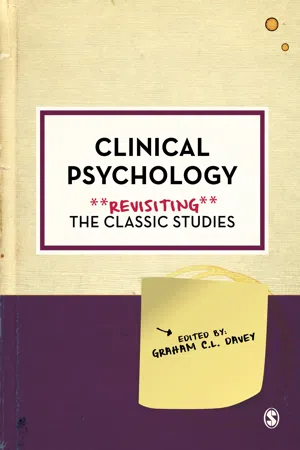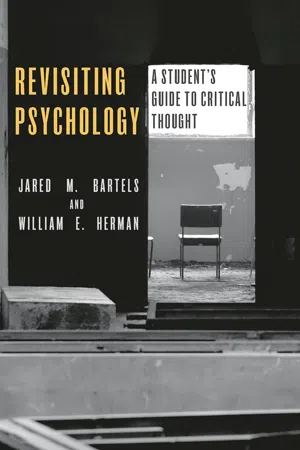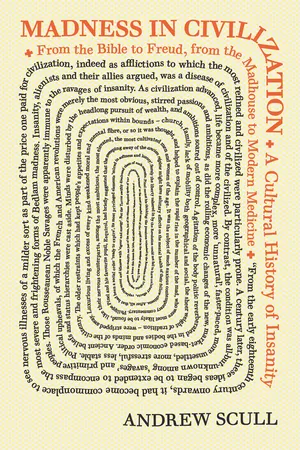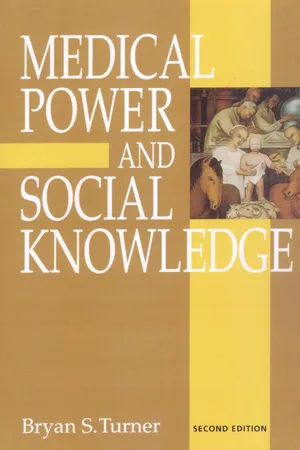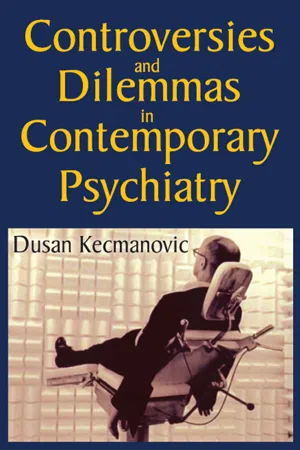Psychology
The Rosenhan Study - The Influence of Labels
The Rosenhan Study was a famous experiment in which eight healthy people pretended to have hallucinations to gain admission to psychiatric hospitals. Once admitted, they acted normally but were still diagnosed with mental illness and kept in the hospital for an average of 19 days. The study highlighted the power of labels and the potential for misdiagnosis in psychiatric settings.
Written by Perlego with AI-assistance
Related key terms
9 Key excerpts on "The Rosenhan Study - The Influence of Labels"
- Graham C.L. Davey, Graham C.L. Davey(Authors)
- 2019(Publication Date)
- SAGE Publications Ltd(Publisher)
1 Defining ‘Insanity’: Building on Rosenhan (1973)Rosenhan, D.L. (1973) On being sane in insane places, Science, 179: 250–8Richard P. BentallBackground: Psychiatry’s Perfect Storm
David Rosenhan was not a clinical psychologist and spent most of his academic career at Stanford University working on the interface between psychology and law (he died in 2012; Ross & Kavanagh, 2013). Nonetheless, his 1973 paper ‘On being sane in insane places’, which was published in the prestigious American journal Science, has long been regarded as one of the most controversial studies in the history of psychiatry and clinical psychology, and has been regularly singled out as one of the most influential ever conducted in the field (for example, as one of the 10 greatest psychology experiments ever conducted in Lauren Slater’s (2004) book Opening Skinner’s Box: Great Psychological Experiments of the Twentieth Century, about which more later).In the study Rosenhan claimed to show that psychiatrists at that time were unable to distinguish between severe mental illness (insanity) and normal behaviour, a conclusion that has since been contested by many commentators. Certainly, as we will see, both the methodology of the study and Rosenhan’s interpretation of the findings can be challenged. However, without a doubt, and whatever its merits as an experiment, the study has cast a penetrating light on some of the most intractable disputes in the study of mental illness. It was not only the product of a long history of debate and disagreement about the nature of mental illness, it also shaped the way this debate1 developed over the following half century until the present day. That debate cannot be understood without considering the history of psychiatry in the modern period.1- eBook - ePub
Revisiting Psychology
A student's guide to critical thought
- Jared M. Bartels, William E Herman(Authors)
- 2018(Publication Date)
- Bloomsbury Academic(Publisher)
The study that is the focus of this chapter suggested that each of these options (A, B, C, & D) has the potential to color the interpretations of clinicians and nurses in psychiatric facilities to the degree that they cannot recognize normal behavior when they see it. That student in the hallway of the psychology department exhibiting behaviors suggestive of test anxiety is, behind the walls of the psychiatric institution, exhibiting pathological behavior. However, such bold claims demand a closer look at the study from which such conclusions are drawn. Let’s take a look.Study backgroundDavid Rosenhan’s view of psychiatry was evident in the title of his celebrated study “On being sane in insane places.” In other words, the psychiatric institution was to blame for mental illness, not the person. In an attempt to investigate life within a mental institution, Rosenhan and seven colleagues gained admission to 12 psychiatric hospitals in the USA. Rosenhan and company (as pseudopatients, but actually researchers) entered the hospitals complaining of voices in their head saying “empty,” “hollow,” and “thud.” The voices or auditory hallucinations were the only symptom they reported. Other than this fictitious symptom and the use of a pseudonym or phony name, the pseudopatients presented their life histories as they actually were – relatively normal. All received a diagnosis of mental illness, and in all but one case the diagnosis was schizophrenia (note the strong interrater reliability in diagnosis here). Once admitted to the institutional setting, the pseudopatients stopped faking the hallucinations and were compliant with staff orders, spent a lot of their time taking notes, and documented their observations at the hospital. Rosenhan (1973) provided several anecdotes about how the pseudopatients were mistreated in the hospitals and how their behavior, even perfectly normal behavior, was now interpreted by staff through the lens of mental illness or psychopathology.We now invite you to go back in history to better understand the social/ cultural context of Rosenhan’s research. The early 1970s might be seen as an outgrowth of the powerful events of the 1960s in the USA. The war in Vietnam had intensified and led more and more people to questions such as: Why are we fighting this war? It was not only this war in Southeast Asia that was questioned. The radical nature of this time soon caused people to select other domains that might ameliorate the ills of society. The Civil Rights Movement, Women’s Liberation, prison reform (after the Attica Prison riot/rebellion in 1971), and the Mental Health Movement were just some of the arenas where protests occurred and change was demanded. Within such a milieu and related to the Rosenhan study, we acknowledge the influence of a radical book (banned by some high school libraries) as a key benchmark for this era. This landmark book, One Flew Over the Cuckoo’s Nest - eBook - ePub
Madness in Civilization
A Cultural History of Insanity, from the Bible to Freud, from the Madhouse to Modern Medicine
- Andrew Scull(Author)
- 2015(Publication Date)
- Princeton University Press(Publisher)
60 The research subjects went to a local mental hospital claiming to be hearing voices. Having been admitted, they were instructed to behave perfectly normally. Most were diagnosed as schizophrenic, and their subsequent conduct was interpreted through that lens, so the chart of one subject who wrote down details about the ward recorded that ‘patient engages in writing behavior’. Fellow patients, but not the psychiatrists, could see that the pseudo-patients were shamming; when the pseudo-patients were eventually discharged, many were classified as ‘schizophrenic in remission’.As soon as Rosenhan’s paper appeared, psychiatrists protested loudly that the study was unethical and the methodology flawed. Their complaints were not completely unfounded, but ‘On Being Sane in Insane Places’ was widely seen as yet another black mark for the profession. Legal scholars began openly to mock psychiatry’s claims to clinical competence. One prominent law review article suggested that psychiatric ‘expert’ testimony was nothing of the sort, but rather was akin to ‘flipping coins in the courtroom’ – and it marshalled an abundance of references to prove it.61There was yet another, perhaps even more important reason why diagnostic imprecision created increasing problems for the profession by the early 1970s. The pharmaceutical industry had discovered that finding new treatments for mental illness offered enormous potential profits. For drug development to proceed, however, and for the regulatory authorities to grant licenses to release new drugs to the market, it was vital to have access to homogeneous groups of patients. To demonstrate that one treatment was statistically superior to another required increasingly large numbers of patients who could be assigned to the experimental and control groups that double-blind testing relied upon.62 - eBook - ePub
Psychoanalysis, Classic Social Psychology and Moral Living
Let the Conversation Begin
- Paul Marcus(Author)
- 2019(Publication Date)
- Routledge(Publisher)
Also worth mentioning is that psychiatrists, like all of us, have the tendency to assume that others have internal qualities that correspond to their observable behaviors. Such an assumption is often made even when external factors could have influenced behavior. Characterizing someone as having a personality trait, like schizophrenia, that corresponds to his or her observed behavior (e.g., auditory hallucination) is called “correspondent inference.” The idea is that when a correspondent inference follows the initial interpretation of a behavior, it completes a first impression—an initial mental representation (the knowledge-fund an individual has stored in memory) of what the other person is like. This can occur automatically and unconsciously. “Correspondence bias,” the belief that people’s acts reflect their inner qualities rather than situational pressures, have accounted for the unanticipated findings of many of the classic social psychology experiments, like Milgram’s paradoxical finding that ordinary people often obey orders that injure innocent victims. Or in the case of Rosenhan’s study, perfectly normal people were diagnosed and treated as psychotic in a state hospital for an average of nineteen days and were misdiagnosed as “schizophrenic, in remission” when released. The diagnosing psychiatrist and treatment staff assumed that one behavior they observed at admission, the pseudo-patient’s auditory hallucination, must reflect the person’s inner characteristics (i.e., schizophrenia) even though other causative alternatives of the situation might explain the behavior (e.g., the auditory hallucination was a harmless, transient phenomenon; a self-serving fabrication relating to family dynamics; a result of alcohol or drug abuse; organically caused; or from toxic psychosis, which vanished as quickly as it came and was not evident during weeks of hospitalization).I have only skimmed the surface of the social psychology research on impression formation and decision-making, but it should be apparent that making a conventional psychiatric diagnosis in an inpatient setting, as in Rosenhan’s study, or in other clinical settings, let alone a credible one, is a very dicey enterprise. There are many criticisms of actual diagnostic practice, specifically of psychiatric classification, the main ones being that diagnostic classes are heterogeneous and they are neither reliable nor valid. In fact, as Barlow and Durand noted in their discussion of the DSM-5 (American Psychiatric Association, 2013), “it has been clear to most professionals involved in this process that an exclusive reliance on discrete diagnostic categories [like in the Rosenhan study] has not achieved its objective in achieving a satisfactory system of nosology” (Barlow & Durand, 2015, p. 95). Moreover, in addition to the problems of comorbidity (the concurrent existence of two chronic diseases or conditions in a patient) and the uncertain boundary between diagnostic categories, “little evidence has emerged validating these categories such as discovering specific underlying causes associated with each category. In fact, not one biological marker, such as a laboratory test, that would clearly distinguish one disorder from another has been discovered” (ibid.).10 - eBook - ePub
Asylum Ways of Seeing
Psychiatric Patients, American Thought and Culture
- Heather Murray(Author)
- 2022(Publication Date)
- University of Pennsylvania Press(Publisher)
80 But perhaps it simply underscored the uneasy boundary between being mentally ill and mentally “well.” The premise of the Rosenhan experiments is quite positivist in its apparent craving for scientific precision: Would these critics have preferred something like a blood test that indicated schizophrenia?Diagnoses now appeared more blatant infringements upon feeling for the sake of feeling as well as agents of estrangement, perhaps the precursors to the ultimate estrangement of institutionalized life. The willingness to question and reevaluate diagnosis entailed not only a more definitive claim to individual emotional integrity and uniqueness but also a reimagining of biological psychiatry in this period, here thought to instill simply emotionlessness and inertia. In an interview in 1988, neurosurgeon James Watts reflected that during the 1960s, given the social tumult and violence in many American cities, fears had emerged that lobotomies would be used for political purposes to quell “violence in the streets.”81 The New Left student activist organization Students for a Democratic Society (SDS) expressed their disquiet over this very idea in a 1973 protest pamphlet about the establishment of a UCLA Center for Psychosurgery whose aim was the reduction of social violence. The organization feared that this center would “study the causes of unrest among the poor and try to develop techniques to stop the mass expression of that unrest.” The authors of the pamphlet pronounced that “docility [is] defined as health, and protest as sickness.”82 They likened lobotomies to harsh punishments in the same vein as the medical discipline of slaves in antebellum America: “cutting off the toes of a runaway slave and cutting out part of the brain tissue of a militant rebel are both clear attempts at suppression rather than treatment.”83 The reference to race is striking here since, as Martin Summers points out, the medical profession tended to think of Black “madness” as uniquely violent, particularly early in the twentieth century.84 - eBook - ePub
- Bryan S Turner(Author)
- 1995(Publication Date)
- SAGE Publications Ltd(Publisher)
It was, then, not any specific mental state that accounted for Hinckley’s mental hospitalization, but rather his illegal and violent actions in the context of such allegedly delusional dispositions. The labelling of inmates as ‘crazy’ and staff as sane in psychiatric facilities presents us with a further ironic example. An ethnographic study of staff and clients in a community clinic in California (Luske, 1990) pointed out that psychiatric staff orientate themselves to labelled psychotics through ‘reverse role-modelling’ and possess a ‘closet insanity’ which, when expressed, is difficult to differentiate from the experiences of clients. The major difference appeared to be that staff referred to a number of rationalizations that explained their bizarre experiences and beliefs, whereas patients offered few such alibis. Stripped away from the rituals of psychiatric diagnosis, the insanity of the inmates and that of the staff may be, on closer scrutiny, difficult to disentangle. For Luske, the fact that staff and patients inhabit the same world for long stretches of time and are marginalized from the wider contexts of economic activity makes this mirroring all the more probable. Perhaps the most powerful example of the arbitrariness of psychiatric classification is the Rosenhan experiment (Rosenhan, 1973). In an entertaining and engaging prose style in the prestigious journal Science, Rosenhan, a psychologist, reported the results of a study which purported to show that psychiatric staff were incapable of discerning between sanity and insanity. In the experiment, eight ‘pseudopatients’ presented themselves to psychiatric hospitals claiming to be hearing voices that uttered ‘empty’, ‘hollow’ or ‘thud’. All were admitted and after admission immediately ceased fabricating psychiatric symptoms. Most were given a diagnosis of schizophrenia and remained on hospital wards for varying lengths of time until discharged with a diagnosis of schizophrenia ‘in remission’ - eBook - ePub
Down to Earth Sociology: 14th Edition
Introductory Readings, Fourteenth Edition
- James M. Henslin(Author)
- 1981(Publication Date)
- Free Press(Publisher)
The experiment is instructive. It indicates that the tendency to designate sane people as insane can be reversed when the stakes (in this case, prestige and diagnostic acumen) are high. But what can be said of the nineteen people who were suspected of being “sane” by one psychiatrist and another staff member? Were these people truly “sane,” or was it rather the case that in the course of avoiding the type 2 error the staff tended to make more errors of the first sort—calling the crazy “sane”? There is no way of knowing. But one thing is certain: Any diagnostic process that lends itself so readily to massive errors of this sort cannot be a very reliable one.The Stickiness of Psychodiagnostic Labels
Beyond the tendency to call the healthy sick—a tendency that accounts better for diagnostic behavior on admission than it does for such behavior after a lengthy period of exposure—the data speak to the massive role of labeling in psychiatric assessment. Having once been labeled schizophrenic, there is nothing the pseudopatient can do to overcome the tag. The tag profoundly colors others’ perceptions of him and his behavior.From one viewpoint, these data are hardly surprising, for it has long been known that elements are given meaning by the context in which they occur. Gestalt psychology made this point vigorously, and Asch13 demonstrated that there are “central” personality traits (such as “warm” versus “cold”) which are so powerful that they markedly color the meaning of other information in forming an impression of a given personality.14 “Insane,” “schizophrenic,” “manic-depressive,” and “crazy” are probably among the most powerful of such central traits. Once a person is designated abnormal, all of his other behaviors and characteristics are colored by that label. Indeed, that label is so powerful that many of the pseudopatients’ normal behaviors were overlooked entirely or profoundly misinterpreted. Some examples may clarify this issue.Earlier I indicated that there were no changes in the pseudopatient’s personal history and current status behond those of name, employment, and, where necessary, vocation. Otherwise, a veridical description of personal history and circumstances was offered. Those circumstances were not psychotic. How were they made consonant with the diagnosis of psychosis? Or were those diagnoses modified in such a way as to bring them into accord with the circumstances of the pseudopatient’s life, as described by him? - eBook - ePub
- Linwood Cousins(Author)
- 2014(Publication Date)
- SAGE Publications, Inc(Publisher)
The first and second editions of the DSM primarily reflected psychodynamic approaches to psychiatry that were dominant at the time. Psychoanalysis represented the most notable psychodynamic approach, and thus the first authors of the DSM were heavily influenced by the work of Sigmund Freud and Carl Jung. In line with psychoanalytic principles, the DSM founders believed that human behavior could be explained by basic drives and motivations, both conscious and unconscious. As a result, disorders and the symptoms of disorders were interpreted in relation to an individual’s experiences, not in terms of a predefined classificatory system.It was not until the release of the third edition (DSM-3) a few decades later that the manual assumed the form by which it is recognized today. Due to the perceived arbitrariness of psychiatry as represented by psychoanalysis, the 1960s and 1970s were characterized by a great mistrust and skepticism toward the mental health field as a whole. In 1961, sociologist Erving Goffman published his treatise Asylums , which read much like an exposé of the current mental health system. Goffman reflected on the ways in which mental health institutions dehumanized patients.A decade later, within psychology, David Rosenhan conducted his infamous Rosenhan Experiment. The experiment entailed Rosenhan and his colleagues claiming to hear voices in order to be admitted into a psychiatric facility. Once admitted, Rosenhan and colleagues engaged in what would otherwise be considered sane behavior, yet because of the initial diagnosis of mental illness, this behavior was nonetheless interpreted as evidence of a mental disorder. Following the experiment, Rosenhan published his study’s findings in an article, “On Being Sane in Insane Places,” wherein he discussed the enduring quality of diagnostic labels, such as those featured in the DSM, and how once assigned a diagnosis, a patient bears that stigma throughout his or her life.Recognizing the antagonism toward psychiatry at the time, the task force for the DSM-3 sought to legitimize psychiatry by grounding diagnostic criteria in evidence-based research. Researchers initiated extensive clinical studies to measure the validity of diagnostic proposals. As part of the movement to make psychiatry an objective science, revisions to the DSM included a five-part axis scheme for comprehensively assessing patients. Axis one comprised mental disorders; axis two, personality disorders; axis three, medical conditions; axis four, environmental factors; and axis five represented a global assessment of functioning (GAF). - Dusan Kecmanovic(Author)
- 2017(Publication Date)
- Routledge(Publisher)
To comment on the results of Spitzer’s investigation, I would point out that it shows that a great number of psychiatrists, more than half, consider auditory hallucinations sufficient indication of psychotic disorder, even when there are no other symptoms. For most psychiatrists, hallucinations and delusional ideas are pathognomonic of psychosis.This finding shows that psychiatrists are far too eager to diagnosis psychotic disorder on the basis of only one symptom—auditory hallucinations. Such a rush cannot be defended.From Slater’s answer to the criticism she received, I would only note her insistence that her experiment was not a study in the academic sense of the word and her critics’ basic mistake was to treat it as such, which means something “quite serious.”I have expanded upon the two best-known cases intended to show and prove that psychiatrists do not know what mental disorder is and therefore are unable to distinguish between the mentally disordered and non-disordered in their daily work. The first experiment, Rosenhan’s, is much better known. It attracted a lot of attention among mental health workers and the public and, rightly or wrongly, played into the hands of psychiatry’s critics The second, Slater’s, whose author says it is nothing but a repetition of Rosenhan’s, is much less known. The goal is the same in both cases: show the low validity of psychiatric diagnoses. And the method used is the same: deceive or try to deceive psychiatrists.
Index pages curate the most relevant extracts from our library of academic textbooks. They’ve been created using an in-house natural language model (NLM), each adding context and meaning to key research topics.
